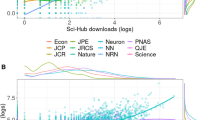Abstract
Link prediction implies the mining of the missing links in networks or prediction of the next node pair to be connected by a link. Link prediction is useful for mining information in citation networks, and most of the existing related studies commonly use degree rather than more advanced methods to measure the importance of nodes. However, such a method cannot easily measure the importance of a paper in reality; some papers have high degree in citation networks but are not very influential. This issue restricts the performance of the link prediction methods applied to citation networks. The current study analyzed h-type indices, which are more suitable than degree for measuring the importance of citation network nodes. We propose two h-index-based link prediction methods. Experiments conducted on real citation networks demonstrate that the use of h-type index to measure the importance of nodes in citation networks can significantly improve the prediction accuracy of link prediction methods.







Similar content being viewed by others
References
Adamic, L. A., & Adar, E. (2003). Friends and neighbors on the Web. Social Networks, 25(3), 211–230.
Ayaz, S., Masood, N., & Islam, M. A. (2017). Predicting scientific impact based on h-index. Scientometrics, 114(3), 993–1010.
Batagelj, V., & Mrvar, A. (2006). Pajek datasets website. http://vlado.fmf.uni-lj.si/pub/networks/data/. Accessed 14 Jan 2013.
Campiteli, M. G., Holanda, A. J., Soares, L. D. H., Soles, P. R. C., & Kinouchi, O. (2013). Lobby index as a network centrality measure. Physica A: Statistical Mechanics and Its Applications, 392(21), 5511–5515.
Clauset, A., Moore, C., & Newman, M. E. (2008). Hierarchical structure and the prediction of missing links in networks. Nature, 453(7191), 98–101.
Ermann, L., Frahm, K. M., & Shepelyansky, D. L. (2015). Google matrix analysis of directed networks. Reviews of Modern Physics, 87(4), 1261.
Getoor, L., & Diehl, C. P. (2005). Link mining: A survey. ACM SIGKDD Explorations Newsletter, 7(2), 3–12.
Glänzel, W. (2012). The role of core documents in bibliometric network analysis and their relation with h-type indices. Scientometrics, 93(1), 113–123.
Gleich, D. F. (2015). PageRank beyond the Web. SIAM Review, 57(3), 321–363.
Guimerà, R., & Sales-Pardo, M. (2009). Missing and spurious interactions and the reconstruction of complex networks. Proceedings of the National Academy of Sciences, 106(52), 22073–22078.
Hirsch, J. E. (2005). An index to quantify an individual’s scientific research output. Proceedings of the National Academy of Sciences, 102(46), 16569.
Kitsak, M., Gallos, L. K., Havlin, S., Liljeros, F., Muchnik, L., Stanley, H. E., et al. (2010). Identification of influential spreaders in complex networks. Nature Physics, 6(11), 888–893.
Korn, A., Schubert, A., & Telcs, A. (2009). Lobby index in networks. Physica A: Statistical Mechanics and Its Applications, 388(11), 2221–2226.
Lü, L., & Zhou, T. (2011). Link prediction in complex networks: A survey. Physica A: Statistical Mechanics and Its Applications, 390(6), 1150–1170.
Lü, L., Zhou, T., Zhang, Q.-M., & Stanley, H. E. (2016). The H-index of a network node and its relation to degree and coreness. Nature Communications, 7, 10168.
Price, D. J. (1965). Network of scientific papers. Science, 149(3683), 510–515.
Salton, G., & McGill, M. J. (1986). Introduction to modern information retrieval. New York City: McGraw-Hill Inc.
Schubert, A. (2009). Using the h-index for assessing single publications. Scientometrics, 78(3), 559–565.
Schubert, A., Korn, A., & Telcs, A. (2009). Hirsch-type indices for characterizing networks. Scientometrics, 78(2), 375–382.
Uzzi, B., & Jones, B. (2013). Atypical combinations and scientific impact. Science, 342(6157), 468–472.
Newman, M. (2010). Networks: An introduction. Oxford: Oxford University Press.
Yang, Y., Nishikawa, T., & Motter, A. E. (2017). Small vulnerable sets determine large network cascades in power grids. Science, 358(6365), eaan3184.
Acknowledgements
This work is supported by National Natural Science Foundation of China (NSFC No. 71203135).
Author information
Authors and Affiliations
Corresponding authors
Rights and permissions
About this article
Cite this article
Zhou, W., Gu, J. & Jia, Y. h-Index-based link prediction methods in citation network. Scientometrics 117, 381–390 (2018). https://doi.org/10.1007/s11192-018-2867-7
Received:
Published:
Issue Date:
DOI: https://doi.org/10.1007/s11192-018-2867-7




